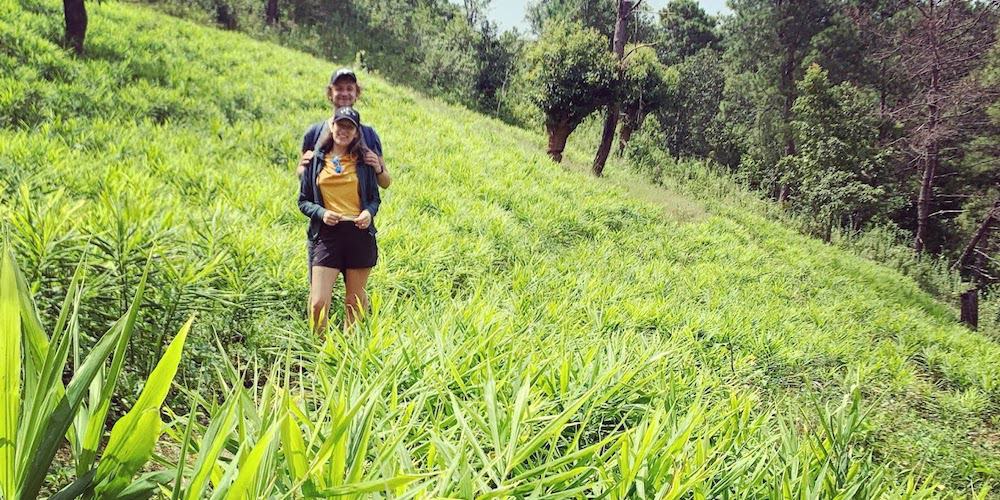Green Tea to Eat
This beautiful country is now referred to as Myanmar, in reference to the kingdom before its colonization by the British. It is nestled between two giants, India and China, whose economic, cultural, and culinary influences are clearly distinguishable.
Despite a complex democratic transition, the violent armed conflicts occurring, and the authority of Orthodox Buddhism which can be oppressive if you are a girl, we loved exploring Myanmar! The Burmese welcomed us with great kindness and shared their cultural, natural, and traditional riches.

This is one of the main dishes of traditional Burmese cuisine. I believe it’s the first thing we ate in Myanmar: tea leaves! Served in a salad with plenty of lemon, garlic, and oil, they make for appetizers. They are also used to cook meat in sauce. As they are fermented, they have a very special, somewhat earthy and bitter taste; in any case, we loved it!

You can find them at the markets: you need to ask for wet or fermented tea leaves. Well, that’s if you speak Burmese! Otherwise, you just point them out: they are always in small plastic packets, unlike the dry leaves used for infusions, which are sold loose.
We haven’t yet addressed green tea (but we will soon!), however, we have a big article on matcha, a green tea whose leaves are specially cultivated and then pulverized. In the case of edible tea leaves in Myanmar, it’s said that they retain the essence of their nutrients, especially antioxidants. We approve 🙂

Volcanic Spirulina in All Its Forms

In the twists and turns of Bogyoke Market, a traditional and artisanal market in the center of Yangon, we stumbled upon a completely retro-futuristic shop. A turquoise blue setting with mirrors as far as the eye can see houses on its stands a no less retro-futuristic food – because it’s 3.5 billion years old but also the food of the future according to us, volcanic spirulina!
Spirulina in wine, as an appetizer biscuit, as an energy drink, in pill form, and even as kibble for pets!

The Burmese consume a lot of spirulina, whether in big cities or rural areas. There’s advertising everywhere! During a meditative retreat at a monastery in the Southeast of the country, the small shop where nuns and monks replenished their supplies sold spirulina!
It is cultivated in volcanic lakes in the Sagaing region, like the one seen in the photo.

Kalaw to Inle Lake Trek: Turmeric, Ginger, and Peanuts as Far as the Eye Can See

60 kilometers separate Kalaw – a mountain town where one escapes the heat, from Inle Lake. It’s customary to cross the mountains and forests on foot, taking a three-day trek where you sleep at local homes in small villages. We made this journey guided by Bone Bone, a young Burmese who enlightened both our steps and our knowledge of Burmese plants, culture, and politics.

Beyond the beauty of the landscapes and experiences – we had never washed in the street half-naked among buffalo and children with buckets of cold water, we were amazed by the number of superfood plantations!

Starting with the ginger fields. The Burmese love it! It is a staple in their cuisine. While we use it to spice up certain dishes, it is central in Myanmar, where the habit is to prepare “ginger salads”.

Another star encountered along the way: turmeric. Bone Bone taught us how to identify the plantations and took some rhizomes for us to taste. It’s strong! We wrapped it in a banana leaf to make a small reserve for the rest of the trek, and we munched on it every morning to give us energy!

And last but not least, peanuts! Yes, yes, the ones we devour frantically as if it was our last meal before the end of the world and we are unsure if they are greasy because everyone puts their fingers in them…
They are actually very healthy, rich in proteins, fibers, and minerals; in fact, it all depends on how we consume them! The Burmese boil them, for example. They plunge the peanuts with their shells in boiling water and eat them hot. It’s absolutely delicious. We had them for breakfast, and some very fresh ones along the way.





We hope you enjoyed learning more about Burmese superfoods as much as we did. In the end, they are also known here, just consumed differently! Next steps: spirulina on the rooftops of Bangkok and fair-trade Moringa in Thailand 🐒🐒
Charlotte & Quentin



